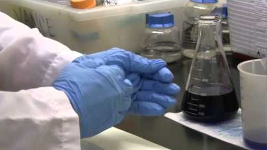Gloves
No glove can protect you from all chemicals!
Protective gloves must be worn while using any hazardous material: chemicals, hot/cold liquids or objects that pose a risk of thermal burns, cryogenics, physical hazards, or equipment that may cause hand injury. The gloves must be appropriate for the material or process being used. The Safety Data Sheet (SDS) for the material should be referenced when determining the type of glove to be used. The Standard Operating Procedure (SOP) for the process will indicate what type of glove(s) should be used. Consult glove manufacturer data sheets for chemical compatibilities of their gloves.
Note that the same type of glove (e.g., nitrile) produced by different manufacturers will have different chemical resistance properties.
Always check the chemical resistance of the specific glove that you intend to use. Contact EH&S if you need assistance locating the chemical resistance information for a specific glove.
Follow these steps as part of normal glove use in laboratory operations.
|
Selection:
|
For concentrated acids and alkalis, and organic solvents, natural rubber, neoprene or nitrile gloves are recommended. For handling hot objects, gloves made of heat-resistant materials (leather or Nomex) should be available and kept nearby. A hot object should never be picked up with rubber or plastic gloves. Special insulated gloves should be worn when handling very cold objects such as liquid N2 or solid CO2 (dry ice). Asbestos-containing gloves should no longer be used. |
|
Inspection:
|
Glove integrity should be inspected before each use. Issues to look for include: elasticity, discoloration, punctures, and tears. Gloves may be checked by inflating with air and submersing them in water to check for air bubbles. |
|
Usage:
|
Use the glove that will provide the best protection for a given task; in some cases this may require multiple gloves. Before some processes, it may be advisable to rinse gloves with a compatible solvent, soap and water prior to handling. |
|
Cleaning:
|
Reusable gloves should be thoroughly washed, either with tap water or soap and water, before removal. After removal, the gloves should be thoroughly dried and then properly stored. Disposable gloves do not need to be washed. |
|
Removal:
|
Always remove gloves before leaving the lab area to prevent contamination of door knobs, light switches, telephones, etc. If transitioning between two lab spaces, it is acceptable to wear one glove to handle lab material while using an ungloved hand to operate doors and buttons. When removing gloves, minimize the potential for contamination by pulling the cuff over the hand. |
Helpful videos
 |
Gloves should stay in the lab. Where are you taking yours? |
 |
Glove Removal Safety
Gloves provide an important protective barrier, improper removal can compromise this protection. |
Cursory information on glove materials.
Note, this is not an exhaustive list.
- Nitrile gloves provide protection against a wide range of solvents. Disposable.
- Chloroprene gloves provide protection against specific chemicals that some other disposable gloves do not. These include materials such as DMSO and ethidium bromide solutions, but may be less resistant to some solvents. Disposable.
- Trionic® gloves, a blend of latex, nitrile and chloroprene, provide protection against strong acids and some solvents/other chemicals. Reusable.
- The Ansell ChemTek viton/butyl glove (aka "UCSF glove") provides protection against both chloroform and phenol. Resuable.
- "Cryo" gloves are insulated to provide protection against cryogenic liquids and extreme cold. Reusable.
- Leather (Nomex and thick knit cotton) gloves provide protection against hot surfaces. Reusable.
- Nomex "pilot" gloves should be worn under a chemical glove for designated procedures involving pyrophoric liquids.
Resistance Chart (Ansell disposable gloves - nitrile, latex, and NeoPro)
Additional Information
Glove Allergies
Lab workers may be allergic or sensitive to different glove materials. Individuals may be allergic to the proteins in Latex gloves or sensitive to the processing chemicals used in any glove material. If you develop skin irritation or other concerns when wearing gloves immediately remove gloves, wash hands, and investigate alternatives. Not all gloves are made equally, it may be possible to use the same glove material from an alternate manufacturer. Please contact EH&S if you have questions or would like assistance in finding a suitable glove.
Glove Contamination
When handling chemicals, it is necessary that the correct gloves be used to protect the worker from accidental spills or contamination. If the gloves become contaminated, they should be removed and discarded as soon as possible. There is no glove currently available that will protect a worker against all chemicals. Please contact EH&S if you have questions.
Chemical Sensitization
Protection of the hands when working with solvents, detergents, or any hazardous material is essential to defend the body against harmful exposure. Contamination of the hands with a potentially hazardous chemical could result in burns, chafing of the skin due to extraction of essential oils ("de-fatting"), or dermatitis. The skin could also become sensitized to the chemical and once sensitized, could react to lesser quantities of that hemical than otherwise would have any effect. It is well documented that primary skin irritations and sensitizations account for a significant number of lost time incidents on the job.
Chemical Barrier
Proper selection of the glove material is essential to the performance of the glove as a barrier to chemicals. Several properties of both the glove material and the chemical with which it is to be used will influence the choice of glove. Some of these properties include permeability of the glove material, breakthrough time of the chemical, temperature of the chemical, thickness of the glove material, and the amount of the chemical that can be absorbed by the glove material (solubility effect). Glove materials vary widely with respect to these properties; for instance, neoprene is good for protection against most common oils, aliphatic hydrocarbons, and certain other solvents, but is unsatisfactory for use against aromatic hydrocarbons, halogenated hydrocarbons, ketones, and many other solvents. Thre is no material to guarantee protection; each potential hazard must evaluated.
Gloves of various types are available and should be chosen for each specific job based on compatibility and breakthrough characteristics. An excellent information resource is Guidelines for the Selection of Chemical Protective Clothing published by the American Conference of Governmental Industrial Hygienists (ACGIH) or information provided by glove manufacturers.

